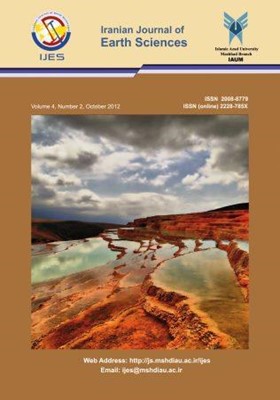Geochemistry, Paleoclimatology and paleogeography of the Northeast Region of the Persian Gulf( Case Study from outhern Hormuzgan, Iran)
Subject Areas : MineralogyMojtaba Taghizade 1 * , Khosro Khosrotehrani 2 , Razieh Lak 3 , Seyed Ali Aghanabati 4 , Hamidreza Peyrowan 5
1 - Ph.D student of Geology, sedimentology, Science and Research Branch of Islamic Azad University.Tehran, Iran
2 - Professor of Geology at Tehran University
3 - Professor Assistant of Geo Science Researching Center, Geological Survey of Iran
4 - Associate Professor, Geo Science Researching Center, Geological Survey of Iran
5 - Professor Assistant, Research Center for Maintenance of Soil and Watershed of Iran
Keywords: Persian Gulf, Paleoclimatology, Paleolimnology, Sedimentary Geochemistry,
Abstract :
The Wisconsin glaciation was started a approximately 125,000 years ago and reached its lowest extend between 20,000 to 21,000 years ago during which the sea level fell 120 to 130 meter. At the end of the ice age, about 18,000 years ago, the sea level increased and reached its present level about 5,000 years ago. The Persian Gulf was exposed in the last glacial moment (LGM). After this moment, the sea level prograted toward the Persian Gulf Basin and reached 1 to 3 meters higher than present levels 4,000 to 6,000 years ago. This study was focused on paleoecology, sedimentation and sea level changes in the northeastern portion of the Persian Gulf and shallow marine area in southern Hormuzgan, Iran near the ports of Bandar Abbas and Shahid Rajaee. Hormuzgan Province is located to the north of Strait of Hormuz. In this study, a core with a length of 10 meters was taken from late Holocene sediments in the northeast marine region of the Persian Gulf using a rotary drilling system. Then different sedimentary types were studied and separated and samples were sent for ICP and XRD elementary analysis and dating. As is already known, increasing and decrease of sea levels are related to moist weather and arid conditions respectively. Additionally, it is proved that variation of elements such as Al, Cr, Fe, K, Mg, Mn, Ti, and Zn have a direct relation to sea level changes. It is shown that the variations of Sr and Ca having a reverse relation to sea level changes. Geochemical study and dating on sediments shows that although the sea level rose 10,000 years ago in the studied region, 3,700 to 6,800 and 7,900 to 9,300 years ago, the sea level and rate of precipitation in this area was higher than the mean. This illustrates an increase in rain and humidity during these two periods

